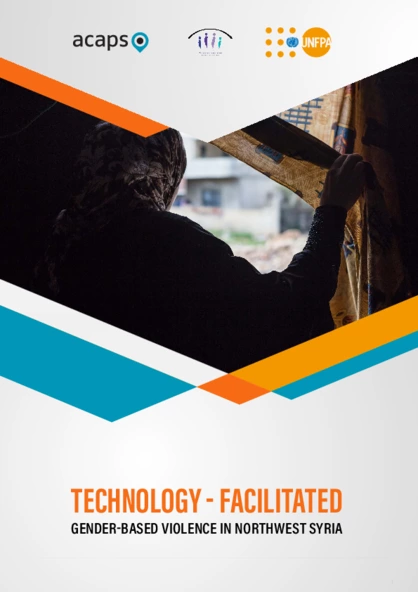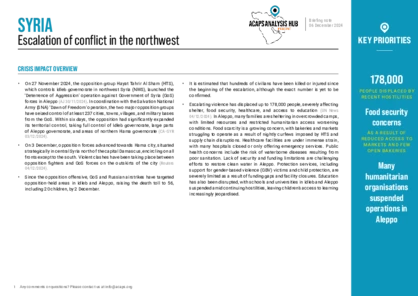Latest updates on country situation
25 June 2025
On 16 June 2025, Israeli forces demolished about 15 civilian homes in Al Hamidiyah village in the countryside of Al Quneitra governorate as part of their regular incursions into southern Syria to establish military posts. The move displaced an estimated 85 people to nearby villages, some of which also reported loss of agricultural land, increasing needs for shelter and livelihoods. (SNHR 21/06/2025, Enab Baladi 20/06/2025, ETANA 23/05/2025)
04 June 2025
Landmine contamination continues to restrict people’s movement and cause fatalities, especially in Deir Al Zor governorate in the east. Between December 2024 and June 2025, landmines and unexploded ordnance killed above 400 people and injured nearly 600 across Syria, with 33% of casualties being children. At the same time, health capacities, including trauma care, are limited. Only 57% of hospitals and 37% of primary healthcare centres are fully functional, and many more are at risk of closure owing to funding cuts and continued sanctions. (OCHA 02/06/2025, MAG 27/05/2025, Health Cluster 03/06/2025)
16 April 2025
By the end of March 2025, one million IDPs and 400,000 Syrian refugees from neighbouring countries, such as Egypt, Iraq, Jordan, Lebanon, and Türkiye, had returned to their hometowns since the fall of the Al Assad regime on 8 December 2024. Returns will likely continue, with an additional two million IDPs and 1.5 million refugees estimated to return by the end of 2025. Their immediate needs include shelter, livelihoods, protection, legal aid, mental health support, and mine awareness. They also face challenges with livelihood and reintegration and need long-term assistance to regain access to essential services, housing, and livelihoods. They are returning to areas with destroyed infrastructure, a collapsed economy, and insecurity, conditions making it difficult for many to rebuild their lives. The 14-year conflict has left 90% of Syrians dependent on aid, with 16.7 million requiring humanitarian assistance in 2025 and over 7.4 million displaced. (UNHCR 11/04/2025, UN 11/04/2025, Al Hurra 10/02/2025)
27 March 2025
The US funding freeze announced in January 2025 and subsequent cuts have severely affected humanitarian operations, particularly in informal settlements and IDP camps across Syria. The cuts have reduced people’s access to essential services, including healthcare, water, and food, increasing the risk of disease outbreaks, food insecurity, and social instability. In northwestern Syria, over 430,000 people across 247 locations, including 195 in Idlib governorate, have limited access to clean water and sanitation after NGO shutdowns. In Sarmada town in Idlib, ten clinics have closed, limiting healthcare access for 35,000 people. In northeastern Syria, at least seven displacement camps have faced food disruptions, with bread distribution halted since 14 February. In Al Hol camp where people highly depend on aid and have no other means to access services, NGO staff have been ordered to cease operations, reducing water, sanitation, and security services and likely triggering riots and breakout attempts. (UN 20/03/2025, TNH 17/02/2025, Reuters 14/02/2025)
12 March 2025
Between 7–10 March 2025, clashes erupted between forces of the Syrian caretaker government and supporters of the previous regime of Bashar Al Assad in Northwest Syria. The violence killed an estimated 1,000 people in the affected areas of Latakkie and Tartous governorates and displaced at least 45,000, who need shelter, food, medical aid, and protection. Insecurity restricts humanitarian access to the conflict area as aid workers fear abduction and physical threats. The fighting damaged six hospitals, several ambulances, and power lines. Many people have crossed to Akkar and Tripoli governorates in Lebanon, including at least 10,000 to Akkar. They take informal routes, as Israeli air strikes damaged the official border crossing during the escalation with Hezbollah in 2024. Issues include a lack of formal registration among new arrivals, a lack of organised aid, and heavy reliance on individual initiatives to provide aid for the new arrivals. (UN 10/03/2025, Sari Global 10/03/2025, TNA 09/03/3035)
19 February 2025
Since early December 2024, clashes in Menbij district in Aleppo governorate have been damaging the Tishreen Dam, rendering it non-operational. This has severely limited access to clean water and electricity for approximately 413,000 residents in Menbij and Kobani districts since 10 December. The dam and surrounding areas became a conflict hotspot after the Turkish-backed Syrian National Army initiated Operation Dawn of Freedom in early December, aiming to seize the area and the dam from the Kurdish-led Syrian Democratic Forces given its economic and strategic significance. Following the recent conflict escalation between the two groups, people in Menbij are experiencing limited access to basic services and essential goods, such as fuel, bread, and flour. Urgent needs also include the repair of the dam, as the risk of structural failure could cause catastrophic flooding that would affect over 40 downstream villages, especially if the dam sustains further attacks. (OCHA 12/02/2025, TNA 21/01/2025, CNN 13/12/2024)
04 December 2024
By 4 December 2024, hostilities between the Syrian army and opposition armed groups, notably Hayat Tahrir Al Sham, had intensified for a seventh consecutive day. Opposition armed groups have captured Aleppo, Syria's second-largest city, and are advancing into Hama city. Main routes in northwestern Syria are blocked, hindering humanitarian access and trapping civilians in conflict zones. The hostilities involve bombing and shelling, as well as Russian air strikes supporting the Syrian army, resulting in civilian casualties. Initial estimates indicate that at least 11,100 families (approximately 68,000 people) had been displaced by 2 December, though specific numbers remain unverified. Essential services such as healthcare, food, and water supply have been disrupted in Aleppo, Hama, and Idleb governorates. Humanitarian operations in those areas have also been severely disrupted. The Syrian Arab Red Crescent and Syrian Civil Defence (White Helmets) continue to provide assistance in their respective operational areas. (UNSC 03/12/2024, SARD 03/12/2024, OCHA 02/12/2024)
current crises
in
Syria
These crises have been identified through the INFORM Severity Index, a tool for measuring and comparing the severity of humanitarian crises globally.
SYR003 - Complex crisis
Last updated 24/06/2025
Drivers
Conflict/ Violence
Political/economic crisis
Drought/drier conditions
Crisis level
Country
Severity level
4.5 Very High
Access constraints
3.0
Analysis products
on
Syria
03 June 2025
Syria: Technology-facilitated gender based violence in the northwest
DOCUMENT / PDF / 1 MB
Technology-facilitated gender-based violence (TFGBV) is a widespread and rapidly growing concern across Northwest Syria (NWS). TFGBV is driven by limited digital literacy, the accumulated effects of protracted conflict, and entrenched conservative gender norms, resulting in the weaponisation of the Internet and significant shame and victim blaming.
06 January 2025
Syria: humanitarian impact overview (October–December 2024)
DOCUMENT / PDF / 2 MB
The Syria humanitarian impact overview is a quarterly publication that provides decision makers with a short, accessible overview of key trends and emerging challenges with the potential to affect humanitarian needs in Syria.
Attached resources
06 December 2024
Syria: escalation of conflict in the northwest
DOCUMENT / PDF / 445 KB
On 27 November 2024, the opposition group Hayat Tahrir Al Sham, launched an operation against Government of Syria in Aleppo. Within six days, the opposition had significantly expanded its territorial control. It is estimated that hundreds of civilians have been killed or injured. Escalating violence has displaced up to 178,000 people, severely affecting shelter, food security, healthcare, and access to education.
29 September 2023
Syria: Capacity-strengthening needs in NWS non-government-controlled areas
DOCUMENT / PDF / 290 KB
This report explores the capacity-strengthening needs of the local NGOs (LNGOs) headquartered and registered in Türkiye and the local responders operating in the nongovernment- controlled areas of Northwest Syria (NWS) – Idleb and northern Aleppo – following the February 2023 earthquake response and the July 2023 non-renewal of the UNSC cross-border resolution. The capacity-strengthening needs are categorised based on the three strategic pillars of the Humanitarian Leadership Academy (HLA).






